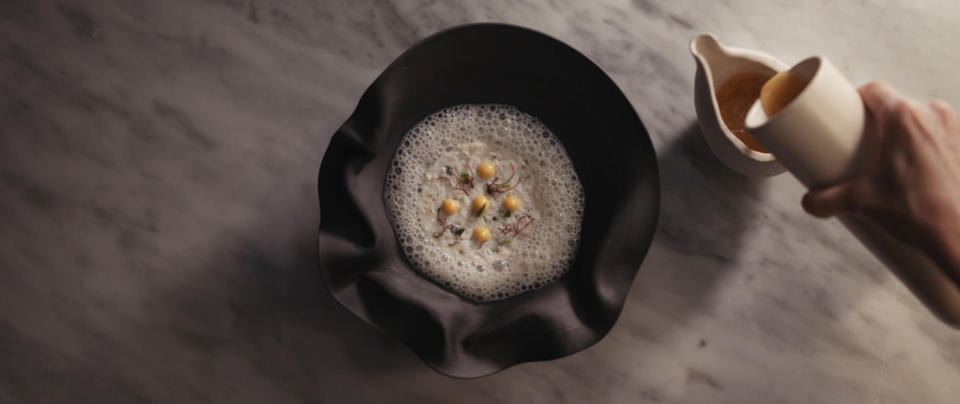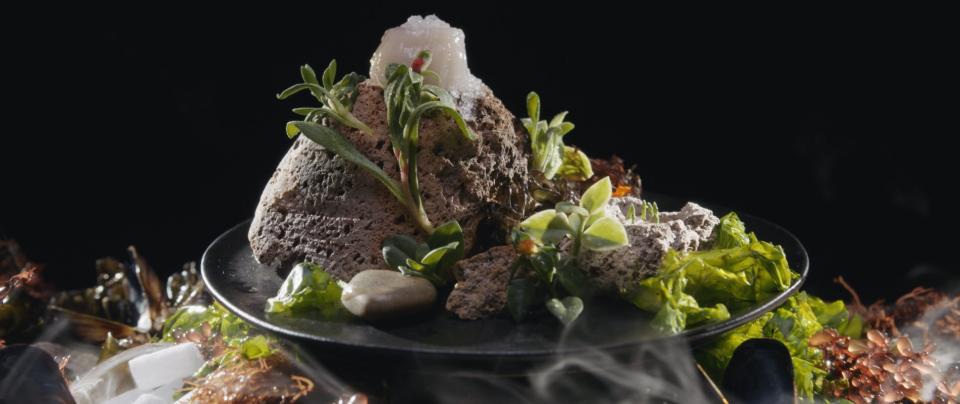Preparing ‘The Menu’: A Recipe for Class Warfare-as-Haute Cuisine in 3 Steps

- Oops!Something went wrong.Please try again later.
- Oops!Something went wrong.Please try again later.
During filming of “The Menu,” food stylist Kendall Gensler occasionally found herself on foam duty. “The foams were, of course, very difficult, because they just die so quickly,” she told IndieWire. “We would foam, they would shoot, die, and then we’d re-foam again.” Gensler would be stage left with a huge bin of sauce and an immersion blender to create new foam for the next take. Thus is the peril of recreating a fine dining experience for the camera.
“The Menu,” directed by Mark Mylod, takes place entirely over a multicourse meal at an exclusive fine dining establishment called Hawthorne, located on a sequestered island that’s ruled over by the exacting and, it turns out, unraveling Chef Slowik (Ralph Fiennes). The dishes are exquisite. There’s “The Island,” which evokes the setting with raw diver scallop, pickled local seaweeds, and algae. “Memory” features marinated grilled chicken thigh (speared with a tiny scissor), tortillas with images printed on their surfaces, and green salsa cubes. “Man’s Folly” includes Dungeness crab, fermented yogurt whey, dried sea lettuce, umeboshi, and kelp. And the food keeps coming even as the dinner devolves into chaos thanks to Slowik’s class warfare scheme, in which a young woman named Margot (Anya Taylor-Joy) is unwittingly ensnared.
More from IndieWire
'Black Panther 2' Tops the Box Office Without Major Challengers, but a TV Show Takes the #3 Slot
Anya Taylor-Joy on the 'Smorgasbord' of Genres in Dark Comedy 'The Menu'
The constant stream of food created a unique challenge for filmmakers who had to both make it edible for the actors and the kind of visually appealing marvel you might see on “Chef’s Table.” It was a process that included help from Michelin-starred Chef Dominique Crenn as well as a collaboration between production designer Ethan Tobman, Gensler, and Mylod — all of whom recently spoke with IndieWire about how the menu of “The Menu” came together.
Step 1: Perfecting the menu
The crew didn’t have to start entirely from scratch when it came to Chef Slowik’s bill of fare. Screenwriters Will Tracy and Seth Reiss had written the basics into the script. “Will is a big foodie so he’d already researched quite carefully what would be a plausible tasting menu,” Mylod said. But from there the team had to refine the dishes, a process that moved inward from the exterior of the restaurant.
“Mark and I decided in our very first meeting that Chef is inspired by nature, in fact he’s obsessed with its perfectionism and haunted by its perfectionism,” Tobman said. “As a result, the restaurant we realized had to be built entirely from materials of the island’s ecosystem.” That extends to the food. The only trouble was they were shooting in Savannah, Georgia, not the Pacific Northwest, where Tobman envisioned a place like Hawthorne would exist. That meant bringing in the flora and fauna of that region for accuracy, and recruiting the founder of San Francisco’s Atelier Crenn. “We were looking for chefs that were deeply inspired by nature,” Tobman recalled. “Chef Crenn famously has a menu that is a poem. It’s inspired entirely by the sea of her childhood, the Normandy landscape, the cold salty air.”
Crenn brought along her pastry chef, Juan Contreras, who worked with Tobman to take what Tracy and Reiss had put on the page and make it visual. The lauded chef was immediately drawn to the script, identifying with Slowik. “I’m not as crazy as he is, but I love the creativity behind it,” she said. “It was so psychologically appetizing for me that I wanted to do it.” Like Tobman, however, she recognized that the food as scripted needed to be more deeply interconnected with the story and the setting. “It was easy to shift the idea of some dishes to make sure to bring something more authentic to the time and place where the chef was,” she said.

Courtesy of Searchlight Pictures
Tobman, of course, was also preoccupied with making sure the food looked good on camera, which he had to convey to the food professionals. “I said, ‘Look, you guys are obsessed with the ephemeral nature of visuals and taste,'” Tobman said. “‘Our medium cannot parlay taste. It’s an entire sensation that you just need to eliminate from your approach. These meals don’t have enough contrast for a camera. They’re not going to look good underneath this lighting.'”
It eventually clicked. They all got excited about the idea of importing blue caviar roe for the amuse-bouche that the visitors are served on the boat into Hawthorne. Even though they couldn’t actually import the delicacy from Australia for filming — in the film, the oyster snack has yellow roe instead — it was a moment that brought the team together. One dish, the aforementioned “Man’s Folly,” was almost directly translated from the Atelier Crenn menu. And the collaboration continued after filming wrapped: Tobman is now helping Crenn renovate her restaurant.
Step 2: Making it edible
Once the menu was in place, veteran food stylist Gensler had to bring it to life, taking into account how the items would hold up when being served on set. Filming happened sequentially, which was helpful for Gensler, because it meant she was preparing as she would in a real-life kitchen. But in recreating Crenn’s ideas, Gensler had to think about smell (you don’t want fish stinking up a soundstage under hot lights) and actors’ dietary restrictions, because the cast would be eating each course. “We had someone that was gluten free, we had someone that was vegan, strictly,” she said. “Anya, her dietary restriction is that she doesn’t eat anything with a face, which is just adorable.”
In the case of “Man’s Folly,” for instance, Gensler replaced the potentially odor-causing Dungeness crab with congee. “To the camera it could have been Dungeness crab,” she said. “But everyone could eat it.” And even though the sauce was scripted as “umeboshi plum,” Gensler used passionfruit curd which looked “more vibrant” on camera. Taylor-Joy loved the “Man’s Folly,” according to Gensler. “She just lapped it up every time,” she says. (For what it’s worth: Mylod cites John Leguizamo as the most enthusiastic eater of the gathered bunch.)
Elsewhere, Gensler subbed in non-dairy yogurt for whipped lardo and a strawberry for liver on the “Breadless Bread Plate,” a series of “savory oils and emulsions” served without bread. It was crucial for everyone involved, however, that the performers could have a pleasant time eating their meals. “What was important was to make sure if we put the dishes that were coming out of the kitchen in front of any actor, that that actor literally could enjoy the food,” Crenn said.

Courtesy of Searchlight Pictures
Step 3: Capturing it
As far as the visual language of the film, Mylod wanted to reference the “absolute touchstone” for food photography: David Gelb’s Netflix series “Chef’s Table.” Each course, for instance, is introduced with a close-up of the dish and on screen text describing the ingredients — sometimes to humorous effect. Mylod was so intent on recreating the glossy, delectable sensation of watching “Chef’s Table” that he brought Gelb in to help him get it right. “We found that despite our best efforts — some really beautiful photography from our gang, from our second unit — that even when I got into the edit I still felt that we weren’t killing that in terms of a pure food porn level,” he said. “I was greedy for a bit more.” So Gelb and his director of photography met up with Mylod and some of “The Menu” team in producer Adam McKay’s office in LA and captured some of Chef Slowik’s inventions himself.
For his part, Mylod — best known for his work on “Succession” — does not consider himself a “massive foodie,” and was ultimately more excited by the appearance of a cheeseburger and fries than anything else. “I came away with a newfound respect after this deep dive of research into this world,” he says. Turns out making good food porn is as tricky as keeping a foam alive.
Best of IndieWire
New Movies: Release Calendar for November 18, Plus Where to Watch the Latest Films
51 Directors' Favorite Horror Movies: Bong Joon Ho, Quentin Tarantino, Guillermo del Toro, and More
Sign up for Indiewire's Newsletter. For the latest news, follow us on Facebook, Twitter, and Instagram.

